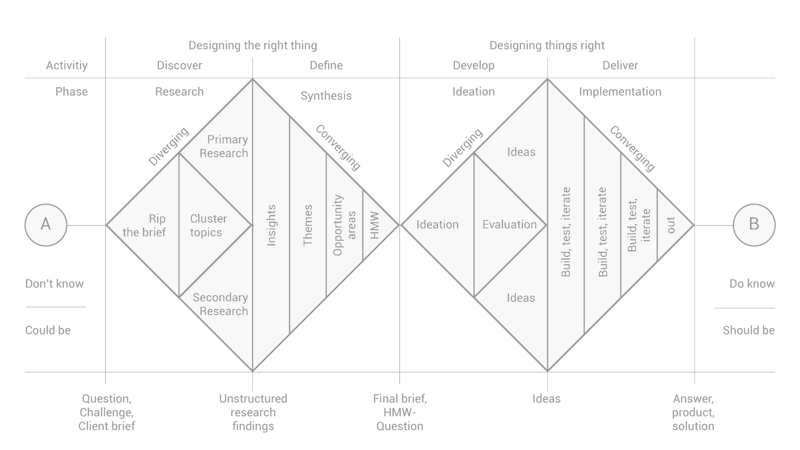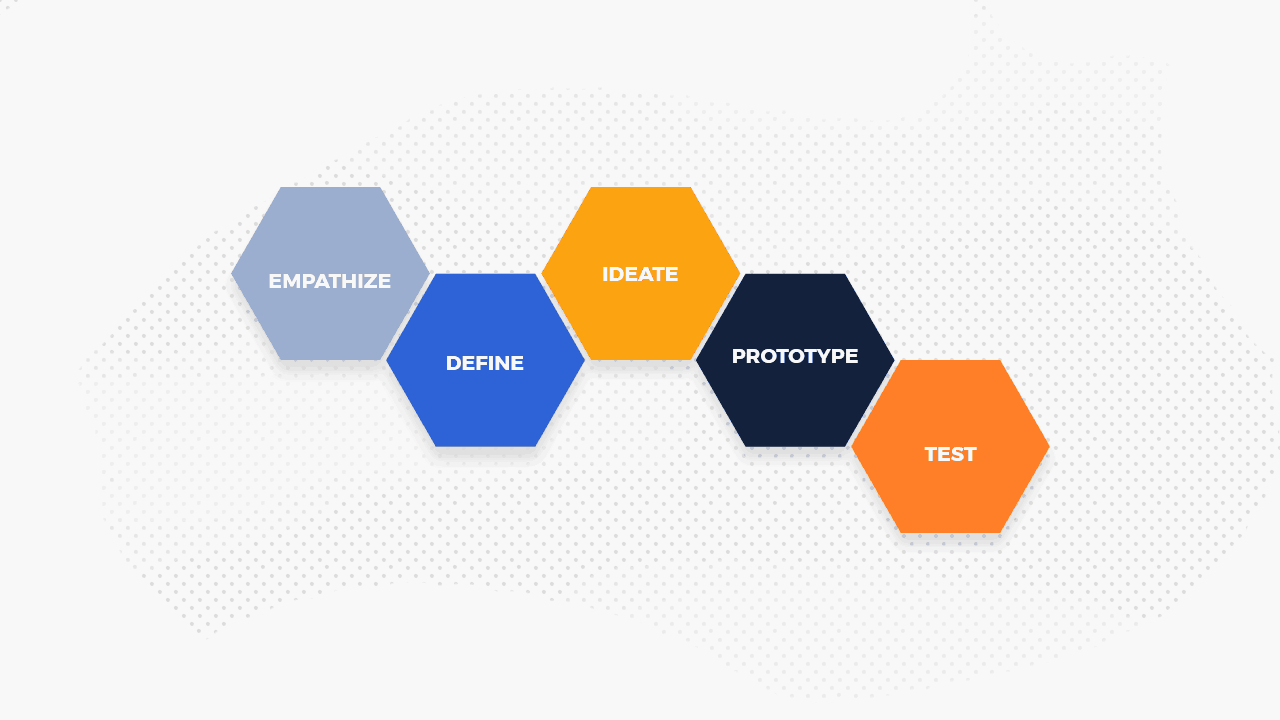This is a complete guide to design thinking.
Learn how to innovate your business using this in-depth post:
Design thinking is a unique approach to innovation. By making it human-centered, it uses elements such as experimentation and empathy to come up with inventive solutions while incorporating the people’s needs, the prospects of technology, and what is required for the success of a business.
Do you ever wonder what makes big corporations like Apple, Coca-Cola, Proctor & Gamble and IBM all standout?
You might think- they have huge talent and a fat wallet bankrolling their projects. Well, there is some truth to that. However, the real reason is far from this. In fact, its something that is not so obvious. So what is it? Design thinking.
This is what has enabled these large corporations to outperform other companies on the S&P 500 for the past ten years by more than 200%. So what is design thinking?
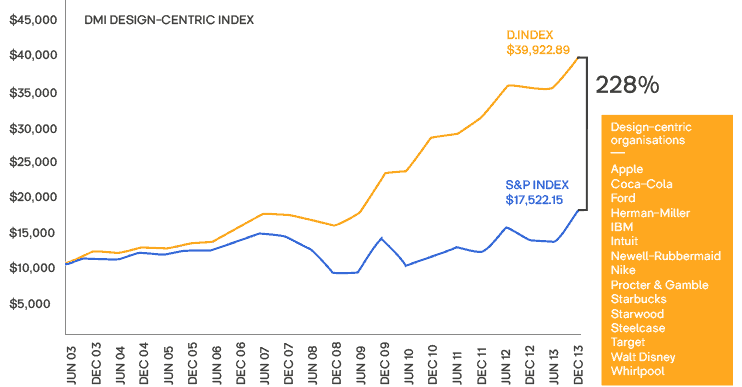
It is unlike using historical data or taking leaps of faith for business success. This strategy seems to be more problem-focused, but on the contrary, it is solution-focused and involves taking actions in order to ensure the ideal future.
Design thinking is not the new kid on the block. In fact, it has been around since the ‘60s, where it was widely used in the science, architecture, and engineering industries. It then made its way into the corporate world through “Wicked Problems in Design Thinking,” a journal article by Richard Buchanan in 1992 that looked into the ways design thinking could be used to deal with obstinate human concerns.
The question that comes into most people’s minds is this: “Is design thinking really applicable in business?” The answer is yes, and it can lead to extraordinary results. This is because at its backbone, design thinking can help come up with strategies and initiate organizational changes.
However, most people dismiss or underrate design, thinking that it is simply about “what something looks like.” But in fact, the principles of user experience comprise three components: how a product looks, how it feels, and how it works.
PS. If you happen to consume content in the video form easier, AND you're a fan of John Snow, we have a treat for you. In this video, we'll explain design thinking through John's life.
So, how does our UX Design studio help incorporate design thinking into businesses?
Before delving into that, we have to understand one thing: Design thinking is not an individual effort. Instead, it involves collaborations between marketing managers, professionals, and business owners, as well as the users. So, with that said, here is an outline of how to solve complex tasks using design thinking.
First, you should employ empathy. This is the development of a deep understanding of the human needs that are in play. The next step is to look at problems from a new light by involving human-centric methods. Ensure that you come up with multiple ideas during the sessions. Next, come up with a prototype, which is a miniature version of the new product or feature. Finally, carry out rigorous tests on the finished product or feature, and make changes where necessary. We shall look at this in more detail later.
Design Thinking and Business Models
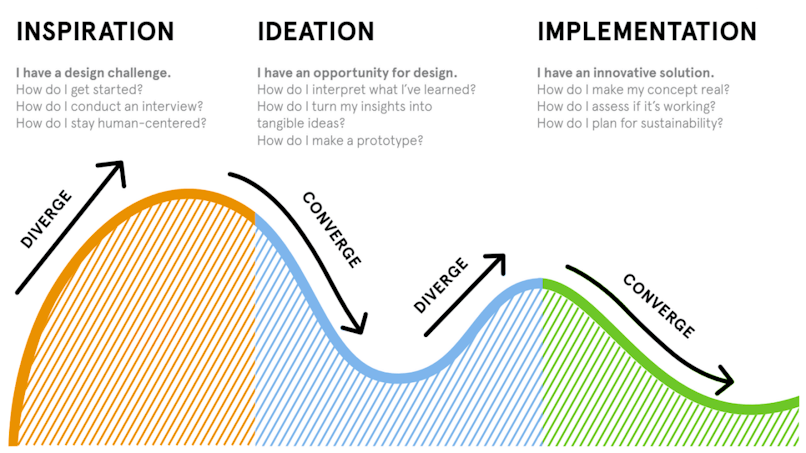
Now that we have seen how design thinking can be used to come up with new products, let’s take a look at how it can be used to formulate business models. In this case, the design process is divided into five steps, which we are going to look at in-depth.
Discovery
In this phase, the focus is to gather data. You want something on which you can base your new business model. As such, it is crucial to know from where you are going to gather the data. If you are clueless about this, start with your customers, and try to have an understanding of their needs, as well as their frustrations.
There are many who are for the idea of looking beyond the walls of the company and into the needs of the customers, as this leads to innovative ideas compared to brainstorming within the company. Meeting the needs of the customer is key to the success of a business.
Also, stay clear of market research agencies or otherwise outsourcing the task. This will prevent you from getting firsthand experience. Instead, roll up your sleeves, and talk to all kinds of customers, be they satisfied customers, discontented customers, and people who would never consider buying your product, as well as people to whom you have never reached out. And feel free to pursue your competitors’ customers.
Understand what makes them feel content with what the industry has to offer and why they opt to buy not from you, but your competitors.
Another place to gather data is to look at the most popular business models within your industry and outside it, which means understanding the workings of an industry and its prevalent business models. This will help you have a clear understanding of what model may not be working and why.
Apart from your customers and other companies, you might also gather data from your “internal customers” by asking them to comment on what they think of the way you do your business and to give an assessment.
Interpretation
After you are done gathering data, the next step is to understand it. For that reason, the goal of this phase is to create a distinct and compelling opportunity in the market.
When trying to come up with a business model design, it is best to incorporate various design-thinking frameworks when analyzing the data. You could, for example, map out the customer’s journey. This will help you to understand their experiences, including what pains them, and most importantly, to identify blind spots in the journey that current offerings or business models are not addressing.
Additionally, ensure that you have a bearing of what the customer is looking to achieve, what job they want done, and what frustrates them about the current customer experience.
When done with this phase, you should be able to have, on paper, opportunities for groundbreaking designs for your business model.
Ideation
Once you have identified opportunities, the next step is coming up with ideas on how to take advantage of those opportunities. In most cases, having pinned down customers’ needs and struggles and coming up with solutions will lead you down Ideasville. Also, you can brainstorm by raising conversation starters such as, “What about …?” or, “How might we …?” Furthermore, you could cut to the chase by researching other industries and business model innovations to find inspiration for your own.
Experimentation
This stage is not about trying out different business models. Successful innovators have struck the most success by only experimenting with a single business model as opposed to many. Besides, very few companies have the resources to try out several model ideas.
In most cases, if the research in previous phases was carried out satisfactorily and you came up with a viable idea, the real issue will be how to actualize the idea. Chances are, if you discover a way to bring it to life, it will be successful.
Evolution
This final stage entails going through the results of your experiences and the experiments you have carried out. In most cases, evolution involves repeating the previous steps as you ideate and add a few touches, and in extreme cases, redesigning the business model again.
When in this stage, keep reflecting on the success of your business model and whether it is of any value to the concerned parties. If not, then it might be time to start the journey of discovery.
A Manual for Innovation
Having seen the ways we can use design thinking to create innovative business models, let’s now determine how we can use it to come up with new products and services. It all comes down to the following five steps:
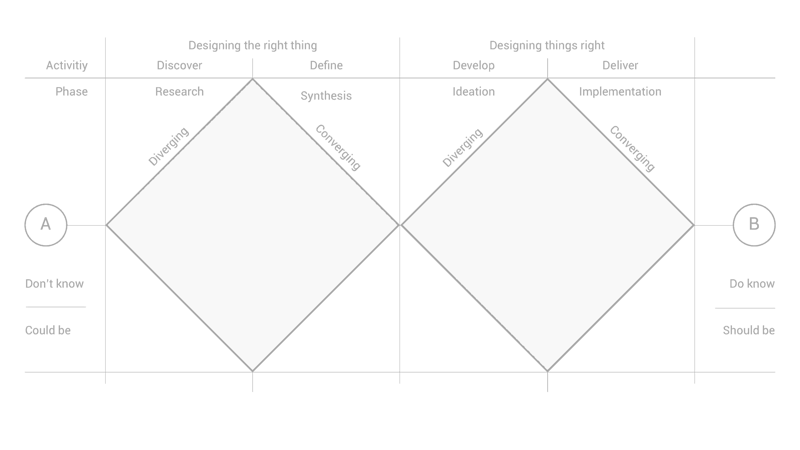
Empathize
In this step, the goal is to show empathy or to get into somebody else’s shoes to develop a fresh or new outlook of things. To make use of this process fully, you can use three steps:
1. Interviews
This involves having interactions with the customers, getting an idea of their workflow, their environment, and their challenges, as well as what they hope to gain from a product or service.
When conducting interviews, establish a rapport, or a strong connection, with your interviewee. Try not to influence their answers. Also, seek stories from them, as these are a gold mine for valuable information. Another tip is to give the user time to think after you ask a question. Even if it leads to silence and awkwardness, don’t cut them short or try to influence them.
Finally, opt for quality over quantity. This means dealing with fewer interviewees but handpicking people who will represent various audiences that will use your product or service.
2. Observation
Another way of getting into the shoes of the user is by observing. Give the user a task and then sit back to watch. This greatly complements interviews.
For example, you might ask a user, “Do you find it difficult buying books on our online bookstore?” And they will probably answer, “No, it’s a piece of cake.” However, if you actually observe that person making a purchase, you can identify any struggles they encounter along the way.
3. Experience
This entails using the product your customer uses, be it yours or your competitor’s. This will give you a front-row seat to seeing their challenges or what they cherish.
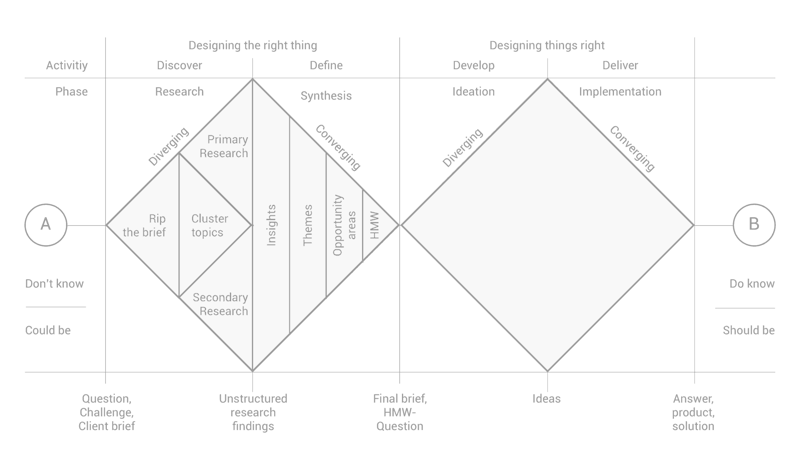
Define
Once you are through with the empathy phase, you should go back to the whiteboard, take a fresh look at the initial design, and try re-defining the problem.
When re-designing, take into consideration the needs and insights of the user. The needs include their emotions and the depth to which they interact with your product or service. Insights, on the other hand, are the surprises you encounter in the first phase, the findings from the interviews and observations, as well as information that may have contradicted what you formally knew. All these should be part of the solution.
Ideate
After going through the first two stages, the third stage involves putting brains to work. It narrows down to two sections:
1. Diverge
In this stage, your team gets together to generate ideas without judging one another. Focus on quantity. This will prevent you from settling on obvious solutions and cause you to venture into the unknown, which harbors innovation.
A few rules by which you might want to abide include: having only one person speak at a time, being visual, staying on topic, encouraging wild ideas, and building on other people’s ideas.
2. Converge
In this stage, choose from the wide array of ideas, the ones you would like to work on. The ideas that get voted on the most are the ones you go with.

Prototype
A prototype translates the idea into something visible or something that can be experimented on. It provides the opportunity to fall down and get back on your feet. It is, in fact, less costly to fail in the initial stages as opposed to failing later after many resources have been rolled out. Prototypes are also an opportunity to learn, settle conflicting ideas, and manage the process.
Test
The final stage involves testing the prototypes on real people. Through testing, we get to refine the prototypes, as well as the solutions. We also learn more about the user, their needs and insights.
When testing, give the users time to tinker with the prototypes while you watch and listen. If you can manage to make small tweaks, do so and then test again. Lastly, don’t hold onto your ideas.
This has been a guide on what you need to know about design thinking. Incorporate it into your business and you will reap benefits.
